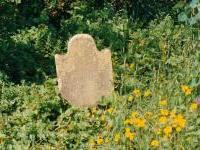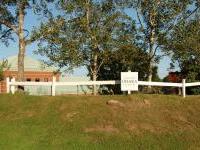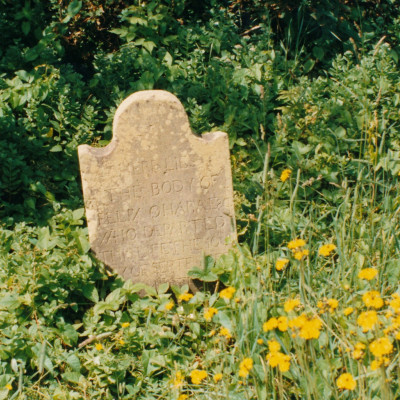 Located in the very heart of the city of Gaspé lies an ancient burial ground -- the O`Hara Cemetery. No one knows for certain how many souls were interred in this place. What is certain is that for many years the site was neglected, left to grow up in brush and weeds. Through the efforts of Heritage Gaspé/Héritage Gaspésie the area was cleaned of debris and brought to its present condition. Take the opportunity to visit the spot and view the graves of some of our early settlers and think back in time to Gaspé of yesteryear.
Located in the very heart of the city of Gaspé lies an ancient burial ground -- the O`Hara Cemetery. No one knows for certain how many souls were interred in this place. What is certain is that for many years the site was neglected, left to grow up in brush and weeds. Through the efforts of Heritage Gaspé/Héritage Gaspésie the area was cleaned of debris and brought to its present condition. Take the opportunity to visit the spot and view the graves of some of our early settlers and think back in time to Gaspé of yesteryear.
 The O'Haras of Gaspe
The O'Haras of Gaspe
The O'Hara's, one of the earliest settlers of the Gaspé Basin area, arrived in Gaspé in 1765. Felix, his wife Martha and family settled on land long known as O’Hara’s Point. Their other holdings included lands that make up much of the centre of present day Gaspé Village. Felix, as well as being a prosperous land owner, played a prominent role in laying the foundations of the Gaspé communities, being made a Justice of the Peace, becoming the second Collector of Customs for the port of Gaspé, and being appointed Judge of the District of Gaspé in 1777. He also helped protect the coast from attacks during the American Revolution, and at the end of hostilities helped to survey and distribute lands to the United Empire Loyalists who came to Douglastown and New Carlisle.
 As well as the efforts of Felix, other members of this family also played an important role in the development of early Gaspé. Of his sons Oliver, became Collector of Customs at Carleton; Edward represented Gaspé in the first legislature of Lower Canada (Quebec), served in the British army, and was appointed the Governor of the Island of St. Lucia in the Caribbean; Henry the youngest son, was Collector of Customs for many years and was also a Justice of the Peace and surveyor; Hugh, Collector of Customs in Gaspé, through his compassionate efforts in helping immigrants sick with fever, caught the fever himself and died as a result. The O’Hara’s also supported the development of education, the establishment of Churches, and served in local militias.
As well as the efforts of Felix, other members of this family also played an important role in the development of early Gaspé. Of his sons Oliver, became Collector of Customs at Carleton; Edward represented Gaspé in the first legislature of Lower Canada (Quebec), served in the British army, and was appointed the Governor of the Island of St. Lucia in the Caribbean; Henry the youngest son, was Collector of Customs for many years and was also a Justice of the Peace and surveyor; Hugh, Collector of Customs in Gaspé, through his compassionate efforts in helping immigrants sick with fever, caught the fever himself and died as a result. The O’Hara’s also supported the development of education, the establishment of Churches, and served in local militias.
Of the original grave markers only those of Felix O’Hara (the patriarch of the O’Hara family), who died in 1805, Mary Stuart, wife of Henry O’Hara, who died in 1838, and Jane Chevalier, who died in 1848, exist today. It is believed that other members of the O’Hara family may have been buried at this site. It is also believed that others outside of the family were buried here as well.
